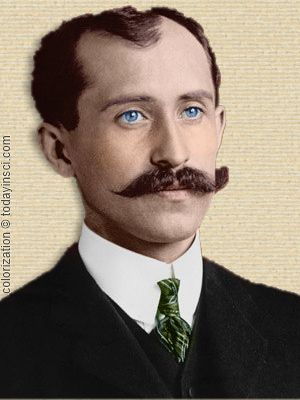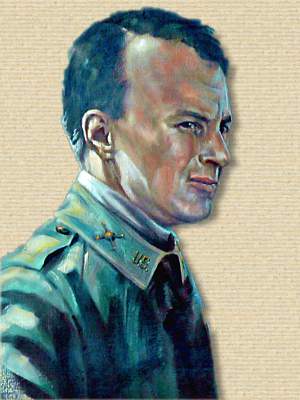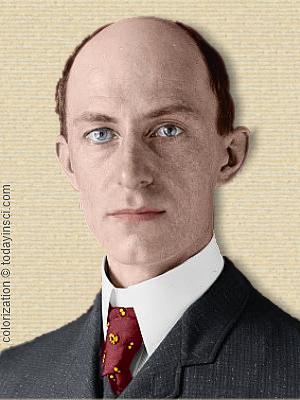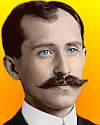 (source)
(source)
|
Orville Wright
(19 Aug 1871 - 30 Jan 1948)
American inventor and aviator , who with his brother, Wilbur, invented the first powered airplane, Flyer, capable of sustained, controlled flight (17 Dec 1903). At Kitty Hawk, North Carolina, Orville made the first ever manned powered flight, airborn for 12 sec.
|
Newspaper Reports of Orville Wright’s Crash
Paris Daily Mail





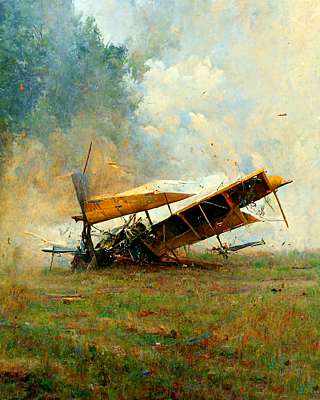
created by A.I. software
After a flight of less than six minutes, Mr. Orville Wright’s aeroplane collapsed this afternoon.
Mr Wright and Lieutenant Thomas E. Selfridge were buried in the wreckage. They are now in the Army Hospital at Fort Meyer, seriously injured; but it is not known how badly. It is feared that both are internally hurt. Mr Wright’s leg is broken.
The accident took place when the machine was making its fourth circle of the field. The great crowd that had gathered saw the blade of the left hand propeller fly off. Instantly the machine fluttered uncertainly like a wounded bird; then it turned completely over, and plunged seventy-five feet to earth. A great cloud of dust rose instantly, shutting off the view of the wreckage.
With one accord the crowd started for the scene far down the parade ground. Colonel Hatfield, in command of the fort, gave quick orders to keep back the curious, and a squadron of cavalry raced ahead. Word was sent immediately to the Fort Hospital, and an Army ambulance and surgeons were hurriedly despatched. Before they arrived, however, civilian physicians had rendered first aid.
Mr. Wright, when removed from the wreckage was conscious. Both were covered with blood, and their clothes were torn and grimed with dust.
It was necessary to lift the machine bodily before they could be released, and Mr. Wright, quizzical and calm even in his extremity, smiled in a wry fashion into the faces of those who went over to him. He tried to speak, but in the confusion could not make himself heard. He was gently lifted to a place only a few feet removed from his wrecked machine.
While a doctor examined him, others extricated the young army officer, To do this it was necessary to lift, not only the great planes of the machine, but also the engine and fuel tank, under which he lay. The rescuing parties were handicapped by the tangle of wires resulting from the wreck.
The real cause of the accident was the breaking of a propeller blade. Only yesterday Mr. Wright removed the propellers with which he has made so many records since beginning his tests here. He believed he could make better speed with longer propellers. He also desired to experiment, because of late he had not been getting all the power out of the engine that he believed it was capable of.
The blade snapped off close to the shaft and was thrown far out from the machine, probably for a distance of fifty or sixty feet. The aeroplane immediately plunged first upward and then downward, then describing an almost complete somersault it crumpled up, fell and lay beneath a great cloud of choking dust. It is believes that the strain put upon the new propellers was too great.
When the left propeller broke the right one continued working and piloted the machine over. The accident happened in the twinkling of an eye, but in the infinitesimal space of time between the breaking of the propeller blade and the crash to earth Mr. Wright stopped his motor. Had he not done so the accident would have been much more horrible, for undoubtedly an explosion would have instantly followed the smash.
It was Mr. Wright’s intention to make a record flight with a passenger to-day. He chose Lieutenant Selfridge, who is connected with the artillery. But was on special duty with the Balloon Corps. He is also secretary to the Aerial Experiment association and an expert aeronaut. He is a son of Rear-Admiral Selfridge, U.S.A., retired.
Ever since Mr. Wright made his first flight here Lieutenant Selfridge has looked forward to an ascent. He was under orders from the War Department to go to St. Joseph (Missouri), where a military congress is in progress, and was to have left to-morrow.
When the wind fell this afternoon Mr. Wright declared the conditions propitious, and Lieutenant Selfridge was in high spirits. As the aeroplane glided from the track and rose in the air he waved his hand gaily to a little knot of fellow-officers. The machine started off the track at fifteen minutes past five.
The inefficiency of the new propellers was evident at the start. For the machine struck the ground after being shot away from the rails and appeared to rise with difficulty. This difficulty disappeared as the aeroplane continued to ascend, until when it was flying at a height of 50 feet it was going as steadily as an express train.
As it passed above the cheering crowd at the starting point on its fourth circle Lieutenant Selfridge and Mr. Wright could be seen laughing and chatting. They stopped their conversation while the Lieutenant again waved his hand to his friends below.
A report is current ton-night that the machine had been tampered with, but the officers declare this has no foundation. There has, however, been much criticism of the laxity with which the machine was guarded before the unfortunate flight this afternoon.
Scores of people were permitted to enter the shed. Numbers of curious twisted the propeller blades and rapped the canvas of the rising planes to test its resiliency.
Mr. Wright on the jolting ride to the hospital lost consciousness. When he recovered at half-past six he looked up at Major Squire, acting chief of the Balloon Corps. "I am afraid we shall not dine with General Crozier to-night Major." He said, and lost consciousness again.
Up to seven o’clock tonight Lieutenant Selfridge had not regained consciousness. Efforts are being made to get into communication with his father. The Admiral is believed to be in London at 4, Trafalgar-square.
Lieutenant Selfridge died from his injuries at ten minutes past eight this evening, after an operation for a fractured skull.
Shortly before eight o’clock the following statement was given out by Captain Bailey, surgeon at Fort Meyer:—
“Mr.Wright is suffering from a fractured left thigh. He also sustained a fracture of several of his ribs on the right side. He suffered from severe shock, but reacted well.”
While the surgeons were setting the limb, Mr. Orville Wright asked the word be carried to Mr. Taylor, his assistant, requesting him to examine the aeroplane and ascertain if anything was wrong with the transmission. Mr. Taylor replied that nothing was wrong.
Mr. Charles White, mechanical expert, who witnessed the accident, states that it was due entirely to defective propellers. He remarked this before the aeroplane ascended, and, according to Mr. White, Mr. Orville Wright did not succeed in shutting of the power, and the remaining propeller continued to revolve, sending the aeroplane to the ground at twenty miles an hour. Mr. White declares that the accident was in no way due to any defect in the aeroplane, and is attributable merely to the faulty construction of one of the propellers.
It is stated at the hospital that Mr. Wright’s injuries consist of a fractured leg below the knee and a slight cut over the left eye. He is conscious, and after the surgical examination dictated a message to his family at Dayton, Ohio, assuring them that he was all right.
Mr. Wright had expected to complete the official trials within a week, and had intended later to compete for the “Daily Mail” prize of £10,000 ($50,000) for a flight from London to Manchester. He was also considering the question of entering for the heavier-than-air competition in St. Petersburg next summer. —Reuter.


Tempted by the glorious weather and a complete absence of wind, Mr. Willbur Wright made two further successful flights to-day. When posts, to which flags were attached, had been placed in the form of a triangle 1,000 yards apart in one direction and 300 yards in the other, the aeroplane made its ascent and described to immense ellipses at an average height of 40 feet. Mr. Wright then came down because he thought his motor was heating. The distance he covered was officially given as 4,600 yards in 6min. 43-2/5 sec.
In the late afternoon Mr. Wilbur Wright occupied himself with fixing a large gasolene tank, with a capacity of 55 litres, to his machine.
At 6.15 this evening, in the presence of over 6,000 people, again brought out his aeroplane, which mounted rapidly to a height of 60 feet. After an admirable turning movement, the aviator recommenced describing ellipses from one end of the course to the other, mounting progressively until he was at a height of 150 feet. At this moment the sun was setting in a glow of red and gold, and as the aeroplane swept round and round above them like a gigantic bird, the crowd burst into enthusiastic acclamations.
Suddenly, the aeroplane flew off in the direction of the military camp of Auvours, a thousand yards from Mr. Wright’s starting-point. After describing an immense circle above the tents, Mr. Wright returned to his point of departure. The average height attained during this flight was over 80 feet. Mr. Wright has never yet accomplished anything which has made a more favorable impression on the spectators. At 7.2 the American descended easily and gracefully after covering 40 kilomètres (25 miles) in 32min. 47sec.
Just as he was landing Mr. Wright caught sight of the rails from which he starts his machine, and suddenly raising his aeroplane, he glided over them in a huge sweep. Altogether Mr. Wright made twelve circuits of the course with the regularity of clockwork. These evolutions lasted three minutes each, but the fifth circuit took over four minutes to make. This, Mr. Wright explained to me afterwards, was because he went further west than before to see what the country was like.
General Poline was one of the first to congratulate Mr. Wright on consolidating his success of yesterday. “It was intensely interesting,” he exclaimed. “You are surely opening the door to the future.”
- Science Quotes by Orville Wright.
- 19 Aug - short biography, births, deaths and events on date of Wright's birth.
- Mr Orville Wright’s Machine Falls - article in Paris Herald (18 Sep 1908)
- The Broken Wing - editorial cartoon - reaction to crash in Columbus Evening Dispatch (19 Sep 1908).
- Today in Science History - events on 17 Sep 1908.
- Science Quotes by Wilbur Wright.
- To Conquer the Air : The Wright Brothers and the Great Race for Flight, by James Tobin. - book suggestion.
- Booklist for Wright Brothers History.
